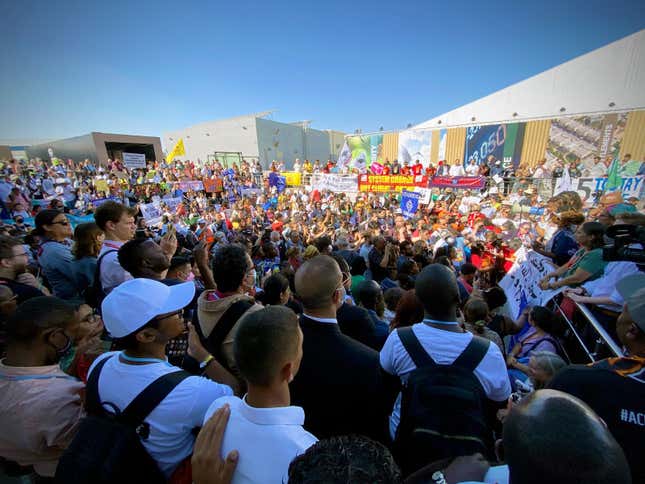Hello COP27 delegates and readers,
One of the biggest climate announcements of the month may not happen at COP27. During the G20 summit in Bali today (Nov. 15), the US is expected to announce a $15 billion aid package for Indonesia to help the country cut its reliance on coal.
The expected deal, called a Just Energy Transition Partnership (JETP), backed by Japan and other countries, advances an initiative announced with South Africa last year at COP26. Although outside the Paris Agreement, the JETP is meant to help a developing country pay for the energy shift needed to reach the Agreement’s global warming aspirations. The deals are being hailed as a promising leap forward in the context of climate talks where tangible progress on raising cash is usually glacial.
But in Vietnam, they’re colliding with tricky financial and political realities. Vietnam, which gets about half its power from coal, was on track to announce the next JETP deal during COP27. The agreement has yet to materialize. It’s bogged down by disagreements over human rights, sovereign debt, and the pace of the country’s transition to clean energy, among other issues. The delay illustrates the challenge of rolling out a fast-track solution to climate change, even when billions of dollars are on the table.
The first problem with the Vietnam deal was its size. The UK and EU diplomats negotiating the deal in early 2022 first proposed a $5 billion package, far less than the one offered to South Africa despite Vietnam facing a similar degree of cost and complexity. “Vietnam was really offended by that offer,” said Julia Behrens, climate director in the Hanoi office of Friedrich-Ebert-Stiftung, a German development nonprofit.
Another issue is what form the money will take. The South Africa deal was comprised almost entirely of loans, as opposed to grants, meaning new debt for the government and the state-owned utility Eskom. Vietnamese officials have been highly reluctant to accept a debt-heavy deal—although donor countries have proven unwilling to offer more grants. Public debt is also a controversial element of the new Indonesia deal, and will likely figure prominently in negotiations next year on proposed JETP deals for India and Senegal.
Another issue—which is also at center stage in COP27 host country Egypt—is human rights. Vietnam has recently imprisoned several leading climate activists on questionable tax evasion charges. Without their voices to improve any new policies paid for with JETP money, the funding risks losing credibility with the coal workers and other local communities it is meant to benefit.
“You need all of society to buy into this kind of deal if it’s going to be successful,” said Jake Schmidt, international policy director at the advocacy group Natural Resources Defense Council. “You can’t have confidence in Vietnam’s ability to deliver if all the leading experts are in jail.”
What to watch for
🚗 Will more countries pump the brakes on gas-fueled cars? Only Canada plus a handful of European countries and US states have set deadlines to end the sale of internal combustion engine vehicles, mostly between 2030 and 2040. Later this week, more such commitments may be coming from India, additional European countries, and others, according to a planning document released by the COP presidency.
📄 Can negotiators find common ground? Heads of state have left Sharm El-Sheikh, and this week, environment and foreign ministers will pick up the reins on negotiations. Issues to resolve before the gavel falls—which the COP president said on Monday could happen by Friday night—include next steps on “loss and damage,” some unresolved questions on carbon credit trading, and whether the so-called “cover text,” which summarizes the outcomes of the summit, will mention the need to phase out fossil fuels.
🤝 What’s next for US-China climate diplomacy? Also at the G20 meeting in Bali, on Nov. 14, US president Joe Biden and Chinese leader Xi Jinping broke the ice and agreed to start a fresh round of bilateral climate negotiations. That could provide an extra push to their respective chief negotiators at COP, and a basis for collaborating on more ambitious compromises with other countries.
A trade deal to fix methane emissions
In the last few years, regulators in Europe and the US have been stepping up scrutiny of emissions of methane, the super-potent greenhouse gas. But its concentration in the atmosphere continues to rise.
COP27 has seen a bit of progress on methane. On Nov. 11, the US proposed tighter restrictions on methane emissions from oil and gas operations. And on the same day, a trade coalition was launched to tackle methane by imposing emissions standards that natural gas exporters must meet to sell to importers. So far, exporters in the group include the US, Canada, and Norway; importers include the EU, UK, and Singapore.
The group hasn’t determined what those standards will be, exactly, but once they do, the rules could have a more immediate impact on methane emissions than country-by-country regulation, said Jonathan Banks, director of methane pollution prevention at the Clean Air Task Force, a non-profit advocacy organization.
“If you have [major gas importing countries] saying we’ll buy gas only if it does this or that on methane, that has a massive impact on the global market,” he said. “This is an albatross around the global gas trade’s neck, and it’s not that hard to deal with.”
Quotable
“On loss and damage, you should be careful of having strong optimism that something will be materialized directly in this COP.”
—Ayman Amin, deputy director of climate in Egypt’s ministry of foreign affairs.
In a brief on-the-fly interview while crossing the COP campus, Amin threw cold water on one of the top aspirations of developing-country activists: to see the creation in Egypt of a new UN-administered fund to manage the collection and distribution of loss and damage finance. Instead, the most likely outcome is an agreement to continue negotiating something like that over the next couple of years.
Protesters stay focused on human rights

Normally during COP meetings, the Saturday in the midway point sees a large protest march through the streets of the host city. Sharm El-Sheikh—comprised essentially of a few highways linking the airport and conference center to resort hotel compounds, with no discernable city center and a formidable security presence—was not exactly conducive to that. Instead, hundreds of protesters rallied within the conference itself, immediately outside buildings where negotiations were ongoing. They included Sanaa Seif, sister of imprisoned dissident Alaa Abd El-Fattah, who had gone on a water strike at the beginning of COP but is now drinking again, according to a Nov. 12 note he sent to the family. One of the main chants: “There’s no climate justice without human rights.”
Pop quiz: Who’s at COP27?
The world’s largest climate conference attracts all kinds of attendees. Delegates from nations around the world are in Sharm El-Sheikh, as are representatives from some of the world’s largest corporations.
Who else? Fossil fuel lobbyists. Many, many, many fossil fuel lobbyists—636 of them, in fact. If attendees from the fossil fuel industry were a bloc of delegates, they would be larger than any nation’s group apart from one. Which country sent the largest national delegation?
🇦🇪 United Arab Emirates, the host country for next year’s COP28.
🇨🇳 China, the world’s most populous nation.
🇧🇷 Brazil, the country that also had the largest delegation at COP26 in Glasgow.
Thanks for reading! We’ll be back in your inbox in a few days with more updates from COP27. Stay tuned.
— Tim McDonnell, climate and energy reporter; Michael J. Coren, deputy editor of climate and emerging industries; Amanda Shendruk, visual journalist; and Morgan Haefner, deputy email editor.
